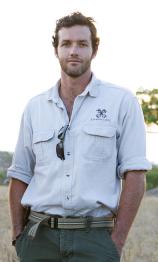Cathedral of the Wild: An African Journey Home
Review
Cathedral of the Wild: An African Journey Home
“By our standards, we weren't in danger. We were Africans." In this remarkable memoir, Boyd Varty describes the manifold crises he and his sister, Bronwyn, experienced growing up “on the wild grounds of my family's home on the western boundary of Kruger National Park, in South Africa.”
Written in a style that can be described best as “idyllic realism,” Varty speaks for the animals as well as the humans in his chosen environment, but most of all, he speaks for family. He paints a colorful portrait of a tight family unit that was able to grow with the times and help others do so, advancing from the mentality that wildlife and native peoples are a kind of theater production put on for our viewing pleasure, to the consciousness of freedom for all.
"[Varty] paints a colorful portrait of a tight family unit that was able to grow with the times and help others do so, advancing from the mentality that wildlife and native peoples are a kind of theater production put on for our viewing pleasure, to the consciousness of freedom for all."
As a child Varty knew nothing but his family, their private game preserve and the animals that inhabited it. His role models were his parents, an intelligent, beautiful couple who ran eco-tours, and his Uncle John, a maverick who sometimes made highly staged wildlife films. The adults let the children roam, though never without shoes. Both kids could drive a Land Rover by age 10, assisting in film shoots all over Africa. Knowing the perils, it seemed they were safe. Varty records that his father always told him to assess the real danger when sighting a predatory animal; don’t just run away. The book, however, opens with father and son trying to deal with a huge black mamba, one of the most poisonous snakes on earth. After their narrow escape, Varty’s mother gives them the usual family remedy for everything from sniffles to full-blown trauma: homeopathic arnica pills.
It wasn’t until Varty and his intrepid sister were sent to an “environmental" boarding school (he maintains it was more of a reform school for kids who had failed elsewhere) that they realized how lucky --- and indeed how spoiled --- they had been at home, or how regimented life could be outside their little Eden. With the new nation experiencing its birth pangs and his parents struggling to make changes in the family business, it was a trying time.
Varty’s lush descriptions --- of encounters with wildlife, film shoots among exotic tribes like the Maasai, travels around the world, a near fatal bout of malaria, a visit from a king that occasioned a fight with a crazed baboon, and later, much remembered meetings in Londolozi with Nelson Mandela --- make most people’s lives seem beggarly. But even he had to go through what many young people must: a journey of self-discovery. Returning from his "gap year" in India and elsewhere, he finds that “While I had been gone looking for healing, it had happened naturally for everyone else in my family.”
Ultimately, and not surprisingly, Varty’s “ego trek” led back to Londolozi, his renewed participation in the family’s business, and in a new project, the Good Work Foundation, promoting digital education in South Africa.
Reviewed by Barbara Bamberger Scott on April 4, 2014
Cathedral of the Wild: An African Journey Home
- Publication Date: March 11, 2014
- Genres: Nature, Nonfiction
- Hardcover: 304 pages
- Publisher: Random House
- ISBN-10: 1400069858
- ISBN-13: 9781400069859




